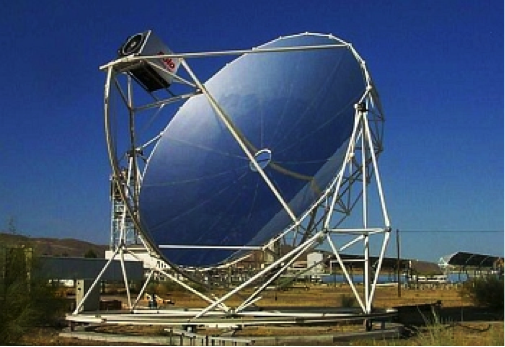7.4. Parabolic Dish CSP Technology
Parabolic dish geometry concentrates light in a single focal point, i.e., all sun rays that are parallel to the axis of the parabola are directed towards the central receiver. This allows this type of collector to achieve the highest concentration ratios among all other type of solar collectors. The dish concentrator must be oriented towards the sun. Usually, losses in this technology are associated with the imperfections of dish alignment and non-ideality of reflection. The engine that converts the concentrated solar energy into electricity is placed at the focal point. This technology can be used for both large-scale power plants (with many dishes grouped in arrays) and autonomous small-scale power generation systems that would provide power to off-grid remote facilities. Example of such a system is shown in Figure 7.3.

Go to the following chapter reading to learn the fundamentals of the parabolic dish CSP technology:
Reading Assignment
Book chapter: Schiel, W., and Keck, T., Parabolic Dish Concentrating Solar Power (CSP) Systems, Chapter 9 in Concentrating Solar Power Technology. Principles, Developments, and Applications., Lovegrove K., and Stein W., Eds., Woodhead Publishing, 2012. pp. 284-321. (See E-Reserves via the Library Resources tab.)
As we can see from this reading, the parabolic dish is a very efficient and flexible technology, which comes in various designs and is suitable for various applications. There are many cases (some described in the history section) of applying this technology in remote locations to provide self-sustained power for water heating, water pumping, and alternative power. One of the features of the dish Stirling systems is their low "inertia" - they start producing power very quickly as soon as direct beam radiation hits the reflector, but, at the same time, they are very sensitive to variations in solar intensity and results in sharp variation in power output and frequent interruptions if the meteorological conditions are not perfect. Because of the high intermittence, energy storage applications which would buffer the power output, would be desirable, but at the moment are not well developed.
Note:
Please take a note of pros and cons of this technology. In the end of this lesson, you will be asked to make a comparison of a few technologies by common metrics. You can revisit some quick facts of the dish Stirling technology by answering the following self-check questions
